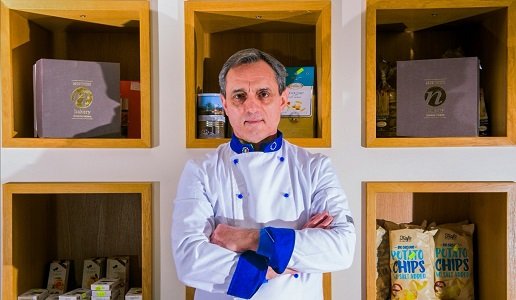Word of Nicola Noschese, a yeast maker by profession, who reminds us of the central role of yeast in traditional Italian desserts, first and foremost Christmas desserts.
Christmas and Easter are so-called holy days. In addition to bringing families together, for better or worse, around the tables on both occasions, there is no shying away from buying (and tasting) traditional sweets. One out of all: the sweet yeast! Whether it’s Panettoni, Colombe, Veneziane, Ofelle or Pandori (I’m from Verona so I’m sorry but, Pandoro is not to be touched!) matters little, as long as they are present.
For years now, landmark pastry shops and top chefs have been signing leavened goods, clearing the air that they are necessarily cheap, standardized desserts (although large mass-market brands do not fail to make more than decent products). The direct consequence is that they have turned into elitist products to which a rather considerable cost is sometimes attributed. A few prices found online to give you an idea: 58€ for Antonino Cannavacciuolo’s, 43 to 85€ for Iginio Massari’s, 49€ for Cracco’s, 55€ for Da Vittorio’s, and so on and so forth. Quality products, we would be sure, for which equally praiseworthy and sought-after ingredients were chosen. They range from PDO to PGI ingredients, all with precise geographic derivation and individuality to defend.
Whether you like dried fruit, candied or semi-candied fruit, chocolate or the use of liqueurs or even wine to unite all those produced there is one thing and one thing only: the central role of yeast. Responsible for their fluffiness, digestibility (or otherwise), and palatability; these elements combine to make them simply irresistible products!
So to understand how to make the choice of the perfect Panettone, or great leavened cake that is, I interviewed another great figure in the leavening scene. He describes himself as a “lievitist” by profession. He is the yeast whisperer; I tasted one of his doves and was literally mesmerized by the perfect blend of elements. I was not only impressed by the flavors and that perfectly calibrated sweetness but also by the human being who was able to transport me into his world and make me taste it from a different point of view. That’s why Nicola Noschese, of the eponymous bakery and pastry shop in the province of Salerno(https://noschesebakery.it/), is the expert I wanted to interview to find out a few more secrets about the art of leavening.
DoctorWine:
Profession and when you start doing this work.
Nicola Noschese: My approach in this field began at a young age, first only with curiosity then, with study and professionalism; in fact, after finishing my studies I began to be part of this small business that over the years has grown more and more, working side by side with my father (the family business began in 1969) I learned the secrets of the trade, the practice of the profession, and the pursuit of quality. Mine is a story of tradition love, craftsmanship and passion.
 DW:
DW:
So is it more passion or work?
NN: Absolutely passion.
DW:
Pwhy lievitist? What does it mean to you?
NN: Lievitist to me is study, expertise and technical training. An approach since the 1990s when yeast control was still done without instrumentation and science. To me, to be a leiter is to possess a talent, to be able then to design a product in the best form.
DW:
What is your period of the year favorite?
NN: Christmas for sure.
DW:
So speaking of Christmas, your best seller?
NN: The great leavened product: Panettone, which then becomes Colomba for Easter.
DW:
Mhe best food/wine pairing with a sweet yeast product?
NN: The sommeliers will get mad, but from my point of view, with a sweet leavened product like a classic Panettone, a classic method bubble really appeals to me. Better still if Champagne. I like how the hints of refermentation, the citrus and floral ones and sometimes even buttery ones go with the panettone enhancing it. A Moscato d’Asti, for those seeking additional sweetness, is also a great classic in my opinion. Of course, the wine must also be good, there is little to do.
 DW:
DW:
We come to the most sensitive question of all… canditi yes or no?
NN: Candied not, semi-candied yes!
DW: Shot in the arm! Then reveal what it is and what is the secret to a good semi-candidate.
NN: A good semi-candid is softer and wetter. This is how it should be in order to preserve more of the flavor and taste of the original fruit.
DW:
Chat makes a good panettone an excellent panettone?
NN: A good panettone must have a good flavor base, using excellent raw materials. Consequently, yeast, which is an ingredient, also determines the excellence or otherwise of a panettone. That’s the real secret of a lieutenant!
 DW:
DW:
A your opinion, was it good or bad that so many celebrity chefs signed the panettoni?
NN: In my opinion, it doesn’t matter who signs a panettone, it could also be a pizza maker, a baker and I would even feel admiration… the important thing is to know how to use the ingredients and especially the use of quality products to create real beauty. The sense of this is lost when too large numbers in terms of commercialization intervene. Inevitably, the quality of the product is lowered, and the use of notoriety and fame is only for profit. You lose the goal of doing something good and beautiful. To sum up…quality always and first!
DW:
Panettone only at Christmas or all year round?
NN: In my opinion Panettone at Christmas. It marks and characterizes a very specific period. Year-round seasonal variations can be made, but we will call them something else.
DW:
Thank you, Nicola, for your sincerity and for making our mouths water.
NN: Now all we have to do is unearth the perfect Panettone for us!







